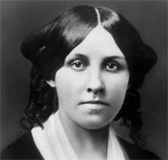Welcome to the first installment of The Louisa Challenge. I hope that you will join us in our online salon as we examine the life and work of one of America’s most popular authors.

Scene from the 1994 movie adaptation of Little Women, starring Winona Ryder as Jo March. The women are reading a letter from their father and husband, Mr. March, who is serving in the Civil War.
According to Jessica of Scholastic, Little Women consistently comes up as a favorite book among people who follow the BookPull blog. The curators at Orchard House say that Alcott’s alter ego, Jo March, “was the first American juvenile heroine to act from her own individuality –a living, breathing person rather than the idealized stereotype then prevalent in children’s fiction.” According to this satirical web site, Little Women is also a book that makes you dumb — I just had to include it because it touched my funny bone to think of English majors going crazy analyzing whether or not the guy from Cal Tech had chosen the correct genre or not! And when you type in Louisa May Alcott on the Amazon.com search engine, you get 10,011 results. As a comparison, John F. Kennedy garners 63,000 hits, and Beverly Clearly only gets about 900. Louisa continues to be talked about and written about far beyond her relatively short period of fame in the second half of the 19th century.

The same scene from the 1949 version of the movie, starring June Allyson as Jo.
This month we are talking virtually about the Alcott family biographies, and there are lots of them! For those who haven’t quite had the time, the Library of Congress has published a simple biography of Louisa May Alcott with lots of related links. We may all want to bookmark this site as we go through the Alcott canon; it’s chock-full of interesting information and photos.
The challenge was to read at least one Alcott biography and respond to a prompt. I’ve chosen Prompt #1.
1. After reading an Alcott biography, how did you feel about the real Bronson Alcott? How do you think his family and especially Louisa were affected by him? Are there fathers like him today?
Mr. March (Bronson Alcott) appears in Little Women as an almost mythical figure; at the beginning of the story he is off working as a chaplain in the Civil War and upon his return, he continues his ministerial work in a local church. As a role model for Josephine March and her sisters, their father is clearly not the driving force. They love him, they respect him, and they try to follow his teachings, but for day-to-day getting-it-done, Marmee makes things happen, not big daddy. It appears that Louisa May Alcott could not face representing her father realistically, but rather than be mean, she just made him disappear.
Based on all sources that I have read, it’s pretty clear that Amos Bronson Alcott was a dreamer, was unrealistic, and depended on others to keep him and his family from destitution. Yet, his personal magnetism and intellectual acuity convinced many people that he should be protected, honored, and saved from financial disaster. I’ve never been able to understand this.

Image via paw.princeton.edu
John Matteson says in the Pulitzer Prize-winning Eden’s Outcasts that “the world had no good yardstick for measuring Bronson Alcott. His inspirations seemed saintly to some and deluded to others.” He was a vegan before the word was even coined, and his vegetarian family wore linen shoes while pulling a plow attached to their shoulders through frozen ground at Fruitlands. He convinced them that it was not only unkind to the oxen to eat them or to use their hides for sturdy boots, it was a sin to ask the animals to labor for the humans’ sakes. Geraldine Brooks invents a fascinating backstory for March/Bronson in March, where March’s pride and faith are tested during his Civil War sojourn in the South, and he returns to his family a different and more humble father and husband. Unfortunately, that’s not what actually happened.
Given his successes and failures and emotional breakdowns, it’s hard to understand why Louisa and her father were somehow psychically joined at the hip. Like any daughter, she wanted her father’s approval, and he rarely gave it to her, despite that fact that for the last two decades of their lives, it was Louisa who kept the family out of the poorhouse. His Transcendentalist indoctrination was so strong that she struggled with her very normal desire to achieve fame and fortune; in Little Women we see Jo “trying to be good” all the time, when she is clearly an altruistic and caring person. Louisa basically was forced into writing not just one, but almost a dozen 19th century chick-lit YA novels that she hated to write, but which kept her parents, sisters, brother-in-law, and nieces and nephews fed, clothed, and housed.
I find it very interesting that Louisa managed to stay alive and making money for twenty years while dying a long slow death from fatal mercury poisoning. She didn’t give up until her father passed away in 1888; at age fifty-six, she died just two days after her father. For a woman who spent her entire life being the “man of the family,” Bronson Alcott’s death allowed her to finally stop caretaking and supporting her entire family. It’s pretty clear to me that Bronson’s irresponsibility — his Pied Piper nature combined with his total inability to sacrifice his principles for the people who loved him — made Louisa May Alcott the woman she became, and thankfully, we are the better for it. It’s a mixed blessing.
Now it’s your turn! What did you read and what do you want to tell the members of our Louisa Salon? Just link up or leave a comment. I can’t wait to hear what you think. Don’t forget to check back regularly for new comments and links and start reading Little Women. Our Louisa Salon meets again on February 13, 2012.
 Your post and button will show up in a new page when you click on the froggie, and don’t forget to grab my button to link back to the Louisa Challenge page!
Your post and button will show up in a new page when you click on the froggie, and don’t forget to grab my button to link back to the Louisa Challenge page!


















